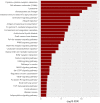Identification and validation of inferior prognostic genes associated with immune signatures and chemotherapy outcome in acute myeloid leukemia
- PMID: 34148032
- PMCID: PMC8266366
- DOI: 10.18632/aging.203166
Identification and validation of inferior prognostic genes associated with immune signatures and chemotherapy outcome in acute myeloid leukemia
Abstract
Acute myeloid leukemia (AML) is a group of heterogeneous hematological malignancies. We identified key genes as ITGAM and lncRNA ITGB2-AS1 through different bioinformatics tools. Furthermore, qPCR was performed to verify the expression level of essential genes in clinical samples. Retrospective research on 179 AML cases was used to investigate the relationship between the expression of ITGAM and the characteristics of AML. The critical gene relationship with immune infiltration in AML was estimated. The clinical validation and prognostic investigation showed that ITGAM, PPBP, and ITGB2-AS1 are highly expressed in AML (P < 0.001) and significantly associated with the overall survival in AML. Moreover, the retrospective research on 179 clinical cases showed that positive expression of ITGAM is substantially related to AML classification (P < 0.001), higher count of white blood cells (P < 0.01), and poor chemotherapy outcome (P < 0.05). Furthermore, based on grouping ITGAM as the high and low expression in TCGA-LAML profile, we found that genes in the highly expressed ITGAM group are mainly involved in immune infiltration and inflammation-related signaling pathways. Finally, we discovered that the expression level of ITGAM and lncRNA ITGB2-AS1 are not just closely related to the immune score and stromal score (P < 0.001) but also significantly positively correlated with various Immune signatures in AML (P < 0.001), indicating the association of these genes with immunosuppression in AML. The prediction of candidate drugs indicated that certain immunosuppressive drugs have potential therapeutic effects for AML. The critical genes could be used as potential biomarkers to evaluate the survival and prognosis of AML.
Keywords: acute myeloid leukaemia; immune infiltration; key genes; survival prognosis; weighted gene co-expression network analysis.
Conflict of interest statement
Figures













Similar articles
-
ITGAM Upregulation in Acute Myeloid Leukemia Leads to Poor Prognosis Associated With Infiltration of Inhibitory Innate Immune Cells.Int J Lab Hematol. 2025 Jun;47(3):481-490. doi: 10.1111/ijlh.14444. Epub 2025 Mar 7. Int J Lab Hematol. 2025. PMID: 40054851
-
lncRNA co-expression network model for the prognostic analysis of acute myeloid leukemia.Int J Mol Med. 2017 Mar;39(3):663-671. doi: 10.3892/ijmm.2017.2888. Epub 2017 Feb 13. Int J Mol Med. 2017. PMID: 28204819 Free PMC article.
-
Disulfidptosis-related lncRNA signature to assess the immune microenvironment and drug sensitivity in acute myeloid leukemia.Sci Rep. 2024 Dec 30;14(1):32015. doi: 10.1038/s41598-024-83560-8. Sci Rep. 2024. PMID: 39738722 Free PMC article.
-
[Research Progress on Role of Long Non-Coding RNA in Occurrence and Development of Acute Myeloid Leukemia--Review].Zhongguo Shi Yan Xue Ye Xue Za Zhi. 2024 Jun;32(3):974-978. doi: 10.19746/j.cnki.issn.1009-2137.2024.03.051. Zhongguo Shi Yan Xue Ye Xue Za Zhi. 2024. PMID: 38926999 Review. Chinese.
-
Stratification of acute myeloid leukemia based on gene expression profiles.Int J Hematol. 2004 Dec;80(5):389-94. doi: 10.1532/ijh97.04111. Int J Hematol. 2004. PMID: 15646648 Review.
Cited by
-
Systematic analysis of prognostic significance, functional enrichment and immune implication of STK10 in acute myeloid leukemia.BMC Med Genomics. 2022 May 1;15(1):101. doi: 10.1186/s12920-022-01251-7. BMC Med Genomics. 2022. PMID: 35501867 Free PMC article.
-
Transcriptome Analysis in Mexican Adults with Acute Lymphoblastic Leukemia.Int J Mol Sci. 2024 Feb 1;25(3):1750. doi: 10.3390/ijms25031750. Int J Mol Sci. 2024. PMID: 38339034 Free PMC article.
-
Comprehensive analysis of immune-related lncRNAs in AML patients uncovers potential therapeutic targets and prognostic biomarkers.Heliyon. 2024 May 7;10(9):e30616. doi: 10.1016/j.heliyon.2024.e30616. eCollection 2024 May 15. Heliyon. 2024. PMID: 38774083 Free PMC article.
-
Identification of pain-related long non-coding RNAs for pulpitis prediction.Clin Oral Investig. 2025 Jan 22;29(1):75. doi: 10.1007/s00784-025-06164-0. Clin Oral Investig. 2025. PMID: 39841251
-
Targeting protein tyrosine phosphatase non-receptor type 6 (PTPN6) as a therapeutic strategy in acute myeloid leukemia.Cell Biol Toxicol. 2024 Dec 21;41(1):11. doi: 10.1007/s10565-024-09965-3. Cell Biol Toxicol. 2024. PMID: 39707066 Free PMC article.
References
Publication types
MeSH terms
Substances
LinkOut - more resources
Full Text Sources
Medical
Research Materials
Miscellaneous

